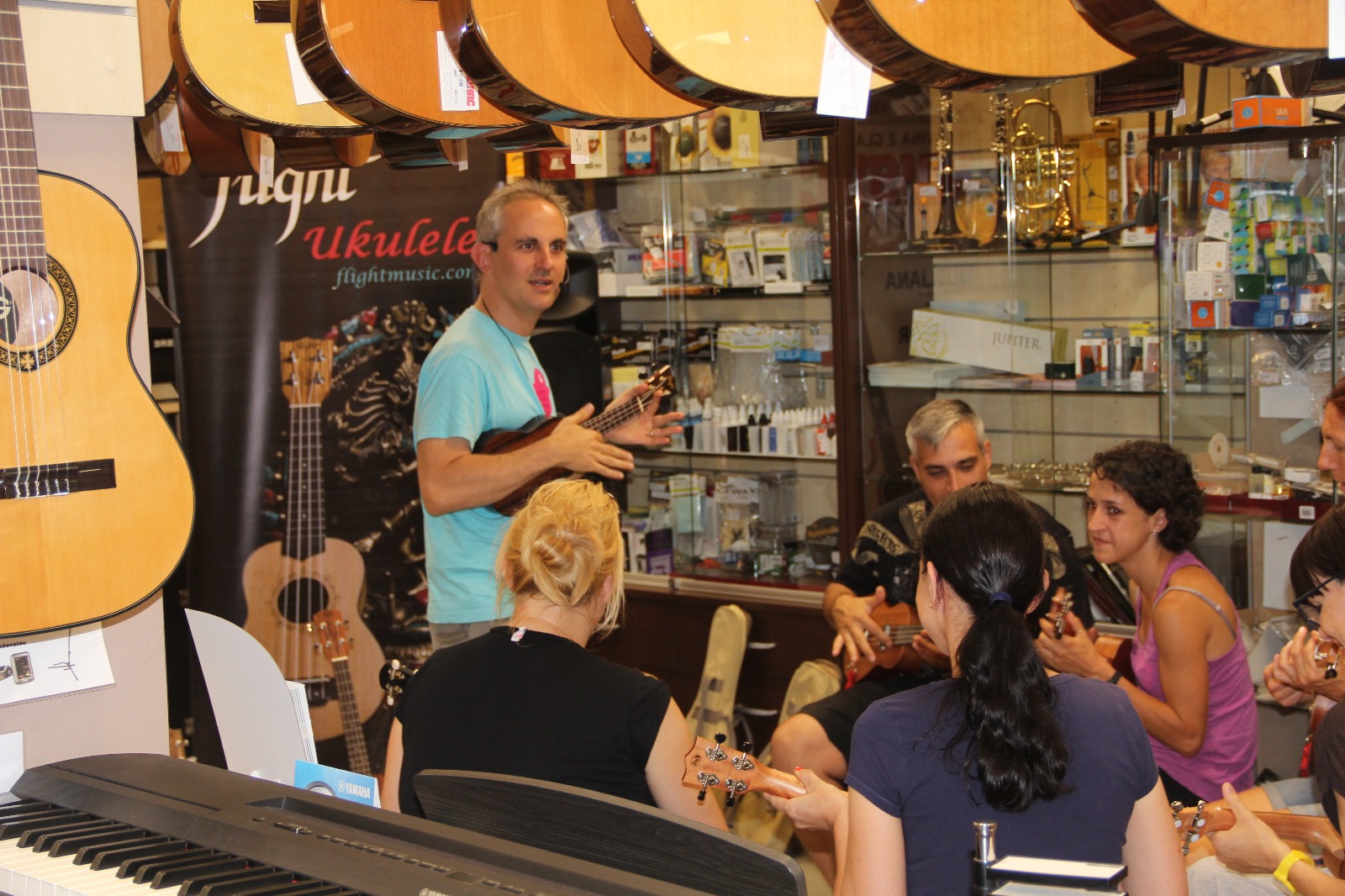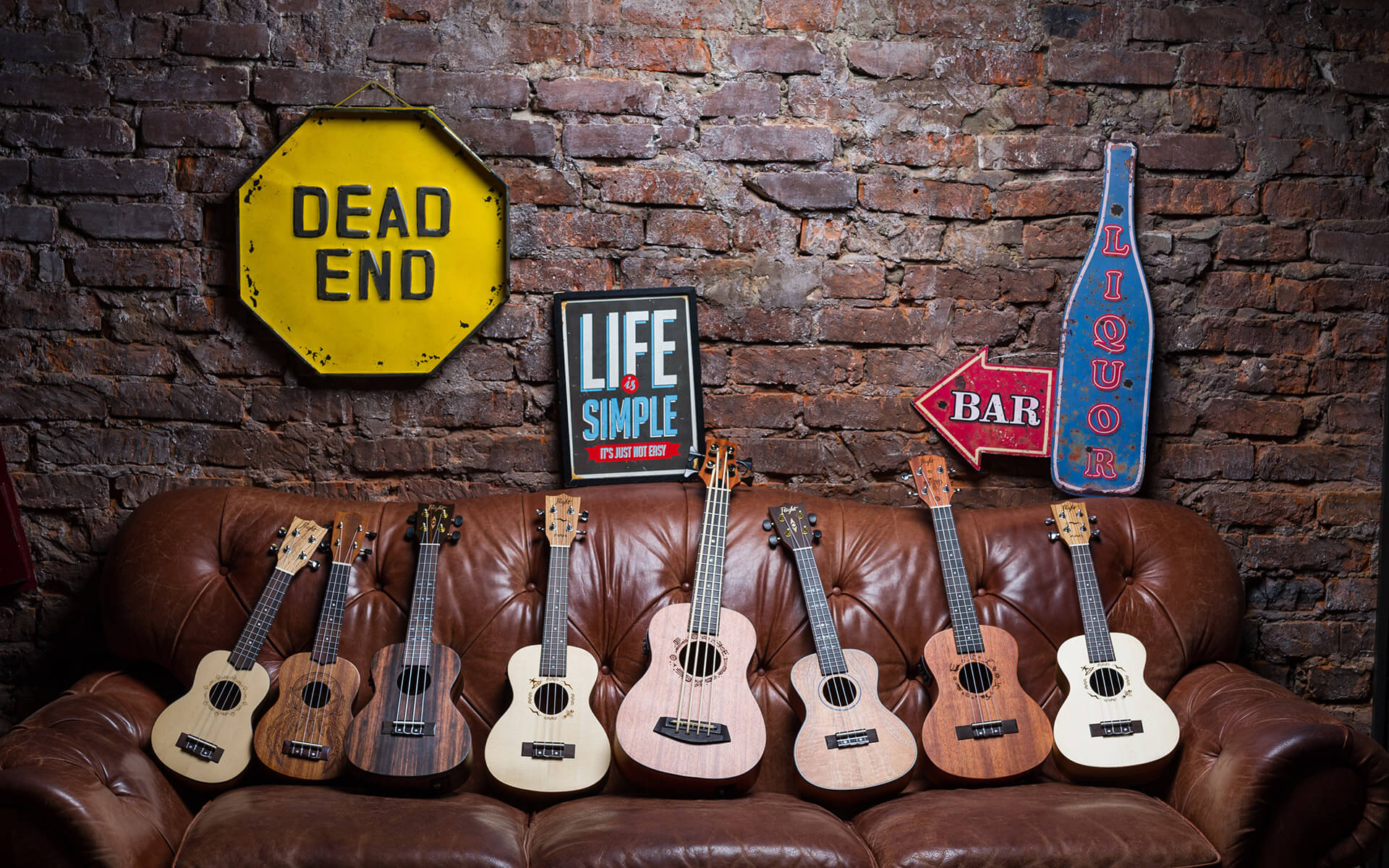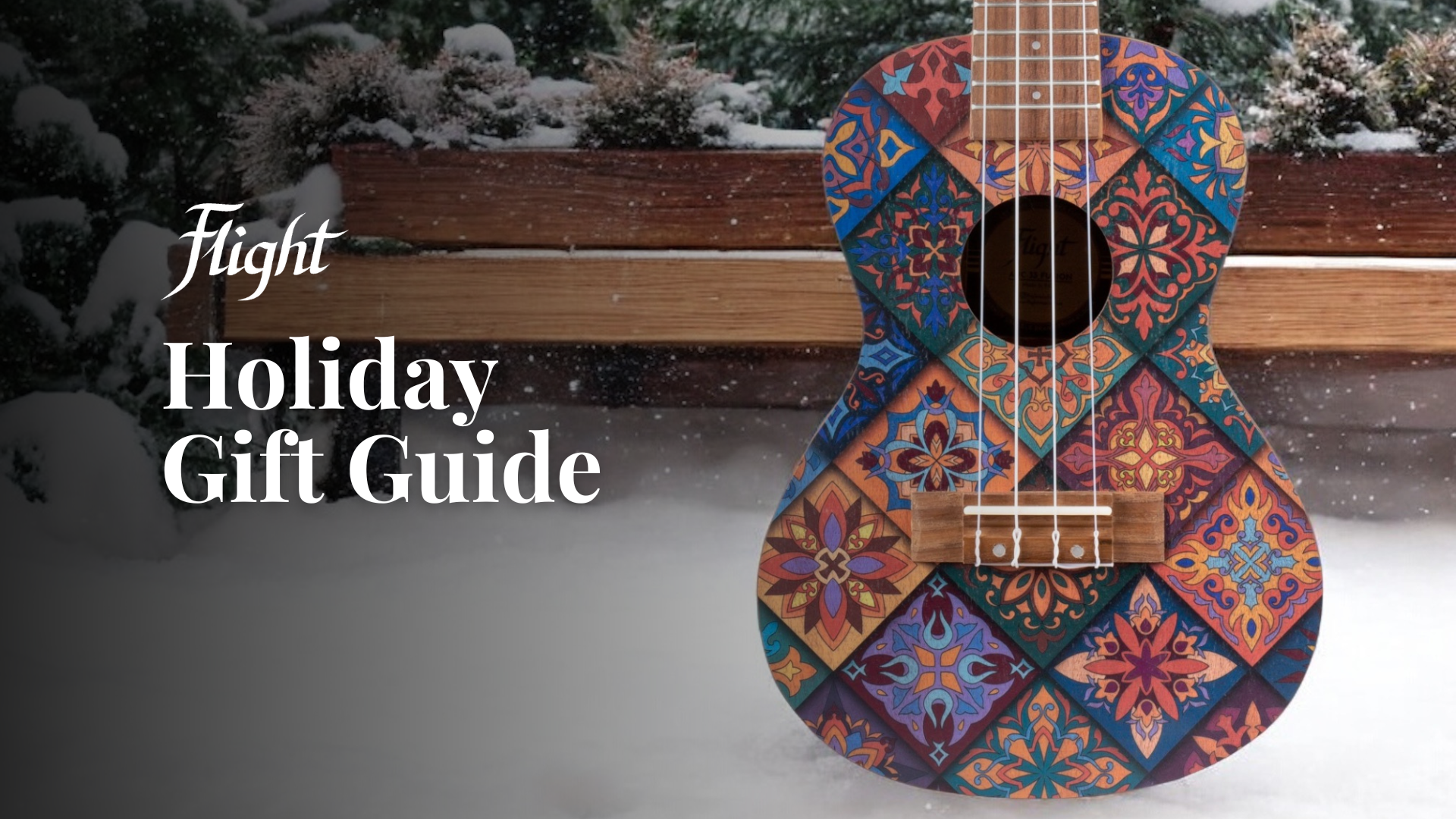Vasko from Ukulele Cheats is going on tour this November with Flight Ukuleles! In Exeter and Dublin, he will…
UKULELE BEGINNERS: Most frequently asked questions
In this section you will find answers to some of the most frequently asked questions beginners have when they start on their ukulele journey.
1. Which ukulele should I buy?
As a beginner, you will most likely choose an inexpensive instrument to start your ukulele journey. That’s fine! However, you will also have to decide which size is right for you. Flight offers great ukuleles for beginners in all four main sizes (or “scales”):
- Soprano: With only 53 cm from head to tail and 12–15 frets, sopranos are the smallest (and most portable!) members of the ukulele family. Often called “standard” in the Hawaiian motherland, sopranos have that classic sound immediately associated with the ukulele, making them the most popular among beginners.
- Concert: They might be only 10% larger than sopranos, but concert ukuleles are louder, warmer in tone, and definitely easier to play if you have large hands. Plus, the larger neck (typically with 15–18 frets) allows concerts to reach higher notes than sopranos. Weird, we know.
- Tenor: Larger still in size and volume, tenors are arguably the most versatile member of the ukulele family. Sporting up to 19 frets, a tenor can do everything a concert can, and then some. Tenors are especially well-suited for trying alternate tunings, making them especially attractive for solo playing.
- Baritone: The largest members of the ukulele family, baritones are usually tuned like the four top strings of a guitar, making them perfect for guitar players who wish to step into the ukulele world without having to relearn all the chords. Due to its size (74 cm), baris have a very warm sound that reminds you of a classical guitar.
2. How do I tune the ukulele?
The most popular tuning for the soprano and concert ukuleles is gCEA, known as “reentrant C tuning” because the G string is tuned one octave higher than what you would expect. Many players prefer a “Low G” tuning (also called “linear C”) with the G string pitched below the C, because of the extended range you get, especially when playing longer-necked ukes such as concerts, tenors, and baritones. Speaking of baritones, those are usually tuned to DGBE, exactly like the four top strings of a guitar.
But that is not all, oh no it isn’t. There are many alternative tunings you can try, such as Hawaiian slack key (GCEG), viola (CGDA), open G (GBDG), or pipa (ADEA). Why not develop your own?
If you need help tuning your uke, just head over to UkeBuddy’s Ukulele Tuner.
3. How do I hold the ukulele?
That greatly depends on the size of the uke, whether you play standing up or sitting down, if you’re a boy or a girl, and if you use a strap. To sum up:
If you are sitting down, try balancing the uke in between your legs or on one of your thighs. In fact some of the greatest ukulele players of all time (Roy Smeck, Jake Shimabukuro, the members of the Ukulele Orchestra of Great Britain) rest their ukes on their thigh when they play. Holding it that way will also help with one of the most important aspects of holding the ukulele, i.e., minimising the amount of contact with your body. Please resist the urge to hug your uke (no matter how much you love it/him/her!) because if you hold it tightly you will stop the vibration of the wood, which will in turn deaden the sound.
Resting the ukulele on your thigh is also the best if you happen to be a busty girl, or when you’re playing larger ukuleles (or both!). Sometimes you will have no choice but to play standing up, though…
If you are standing up, hold the ukulele by two points: (1) between the forearm of your strumming arm and your body, and (2) the underside of your fretting hand. Make sure the thing doesn’t slip out of your hands too often, and you’ll be fine. It might take a bit of practice, but it’s worth it.
Although I personally almost never use one, there are clear benefits to using a strap when standing up. Above all, you will not have to juggle your holding position at all when playing, and for those with large mammalian protuberances, it is kind of a must. When using a strap you can also prance around and even dance, as the lovely virtuoso Taimane Gardner is famous to do.
Now, you can use a guitar or mandolin strap if you have one, but you will have to install a strap button. You can try using the sexy-sounding-but-boring-looking Uke Thong if you feel like it, but I personally would recommend just tying a bootlace around the uke’s body, looped around your neck, and keep going.
4. What is the quickest way to learn how to play the ukulele?
So, you want to read the “quick start” guide instead of the whole instruction manual? Follow these steps, then:
- Get a beginner soprano ukulele, something good and inexpensive like the NUS310 (see answer #1 for more).
- Tune it to gCEA using UkeBuddy’s Ukulele Tuner (see answer #2 for more).
- Hold it as well as you can (see answer #3 for more).
- Learn to play some basic chords, like C, F, Am, and G7. Flight has put together a nice chord chart you can download here.
- Use the Internet to find the lyrics and chords to a cool song you want to play.
- Strum, sing, enjoy! Stop when your fingers start to hurt.
- Find another song. Lather, rinse, repeat.
There are thousands of ukulele websites out there. For lessons, tabs and chords I personally recommend Ukulele Underground, especially their short-and-sweet series “Uke Minutes“.
Last but not least, check out Flight’s own instructional booklet, which features chord charts, strumming patterns, and chord progressions.
5. Which wood has the best sound?
The best ukulele is the one you have with you.
Having said that, certain woods have tonal personalities that, when combined with build craftsmanship, playing technique, and room acoustics, can dramatically affect the overall sound of the instrument. And it’s not just tone, though – some woods are beautiful to look at, and it’s a well-known fact that good-looking ukuleles are harder to put down than average-looking ones. Fact!
- Amara: A species of evergreen tree native to the rainforests of South America which lends gives ukuleles a unique warm-yet-clear tone. Every amara instrument looks different, sporting different variations of stripes, patterns, or even pitch black. We have a few all-amara ukuleles in our catalogue, including the DUC460 CEQ and DUS460.
- Koa: A type of acacia tree that grows only in Hawaii, the native home of the ukulele. Koa is the traditional choice of wood for making ukuleles, and it looks simply stunning. We have a few all-koa ukuleles in our catalogue, such as the DUS440, the DUC440, and the DUC445
- Mahogany: A hardwood which has been used to make quality musical instruments for centuries. Its colour can vary a fair amount, from a pale pinkish brown to a darker reddish brown, and it tends to darken with age. Do not let the “sober” look of mahogany fool you, though–mahogany ukuleles pack quite a punch! We have a few all-mahogany ukuleles in our catalogue, such as the DUC523CEQ MAH/MAH, the DUC323 MAH/MAH, and the DU-BASS.
- Mango: Usually golden brown in colour, Mango’s heartwood often is streaked with yellow, pink and/or black. Mango is considered to be more sustainable wood, and it provides a warm and bright tone reminiscent of walnut. We currently have two all-mango ukuleles in our catalogue, the DUC450 MAN/MAN and DUS450 MAN/MAN.
- Sapele is a light hardwood from tropical Africa with a golden to dark reddish brown colour. A close relative of mahogany, its grain is interlocked, and has a uniform texture and good natural lustre. Its natural resonance is boosted and concentrated by the arched back of all our instruments (such as the NUS310, the NUC310, and the NUS350, yielding a clear and bright tone.
- Spruce: A soft tonewood used since time immemorial to make musical instrument soundboards. Its colour is typically creamy white with hints of yellow and red, and instruments made from spruce typically have a bright and clear tone. We have a few spruce/zebrawood ukuleles in our catalogue, such as the DUC525 SP/ZEB and DUC325 SP/ZEB.
- Zebrawood: A hardwood from West Africa that is light brown or cream in colour, with dark brown streaks resembling a zebra’s stripes. Thanks to its lovely coarse texture, open pores, and wavy grain, instruments made from zebrawood look very special. We have a few Spruce/Zebrawood ukuleles in our catalogue, such as the DUC525 SP/ZEB and DUC325 SP/ZEB.
Comments (11)
Comments are closed.








I am considering buying one the baritone ukulele NUB-310 and was wondering, does it have a truss rod? I want to use the c tuning but have the G tuned low for jazz and blues playing. Have you ever had any issues with the necks warping on these units. Also, is the action pretty low or will it have to be adjusted once purchased?
Thank you…..
Hi,
The NUB310 made after May 2017 have a truss rod installed, so it should help with the neck bending. Action is a standard height, so it should work with most of the players (but of course it depends on the player).
thanks !
Hallo,
we bought a travel flight. It is a nice ukulele with a good sound.
we have a question: how can we fix buttons to have shoulder strap at the uke?
Best Wishes Marion
Hi,
We suggest to use a sound hole strap, so no drilling is needed. It can be done with a skilled professional, also the plastic reacts a bit different to drilling than wood.
The easiest is just to buy a sound hole strap.
thanks !
You could also use Sugru to attach the strap buttons
I have kala ka-15s mohagony ukulele. It’s produce very well sounds. I just love it!! And thanks for sharing the very informative article..
What strings are fitted on the NUB310 baritone? Are the lower 2 strings wound and the top 2 nylon?
Hi,
The strings on NUB310 are all nylon and not wound.
thanks !
Thank you for the previous answer.
What tuning are the factory-fitted strings on the NUB310? GCEA or DGBE?
Also is the 4th string (D or G) high (re-entrant) or low?
Hi, it comes with DGBE tuning, D(G) is low unwound.
thanks
Hello my name is Shamini I have Ukulele Flight model : Travel / TUS-50 when I look at tutorials my ukulele sound really different from the videos I watch and I just brought it. As beginner it is difficult for me start so I need help.